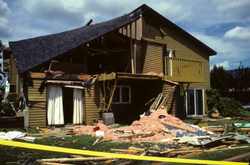It’s not necessary to tell you that insurance companies realize this too. That’s why buy to let home insurance usually will cost you more than a average homeowner’s policy.
The simple fact that the landlord does not live on the premises and rents the home or apartments also means the house is much more likely to be vacant than the normal homeowner’s dwelling.
While you may have excellent tenants whom stay for years, at some point in time they’ll move out and regardless of how well they treated the house, there’s usually work you need to do before the next tenant can move in.
The loss of a tenant usually means the home will probably be empty until you finish the work and locate the next great renter.

Again, this exposes the home to even more dangers from vandals to water damage if a pipe would break with no one around to discover the problem for a while.
Buy to let home insurance providers won’t pay a claim if the property has been empty for as little as 30 days in some states or slightly longer in others. It all is determined by the carrier and your state laws. In order to be positive that you have full coverage, get buy to let home insurance policies that provide a rider for these occasions the home is empty. It extends coverage while you are doing repairs, locate just the perfect tenant, and is very well worth the extra premium.
The option to a rider on your buy to let home insurance would be to switch to a builder’s risk policy when you’re refurbishing the property. However, these can be expensive and often quite hard to get. Talk about this issue with your insurance agent so you aren’t stuck at the last minute trying to obtain insurance or worse yet, file a claim and find you had no coverage because the dwelling was empty.
Make certain that you have adequate coverage on your policy. Similar to homeowner’s insurance, insurance companies prorate all claims in the event you do not insure to 80 percent valuation of the home. While you may have only paid $50,000 for the home 20 years ago, today it might be worth considerably more in the event you sold it, especially if you have made improvements in the property.
Presume you’ve got a $100,000 property that you just only insure for $50,000. In the event you have roof damage from a storm estimated at $3,000 for repair, initially the buy to let home insurance provider estimates the amount of money they pay. Since you only insured for half the value of the house, they only pay you half the cost of damage or $1,500. The company then subtracts your deductible from that value. In the end, you’d only get $500 if you had a $1,000 deductible. Had you insured the property for $80,000, 80 % of the worth, you’d receive $3,000 less the deductible. There’s really a spread between the two figures.
Make certain you have adequate loss of rent coverage in your buy to let home insurance. In some cases, the loss of rent can make a big difference in whether or not you’ll make that next payment on the house on time or struggle and pay penalties to your lender.
Some buy to let home insurance policies have liability in the policy but you’ve got to add it to others as a rider if it’s even offered. A lot of personal homeowner insurance policies make available a rider that supplies liability coverage for a rental or other property. If you have many properties, an umbrella liability policy may be the very best bargain for your needs. Discuss this together with your insurance agent for the very best answer.